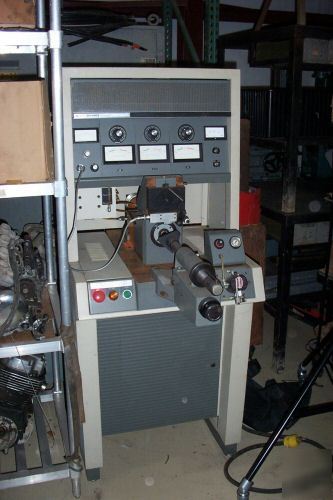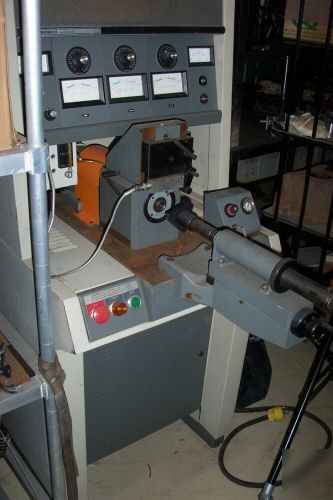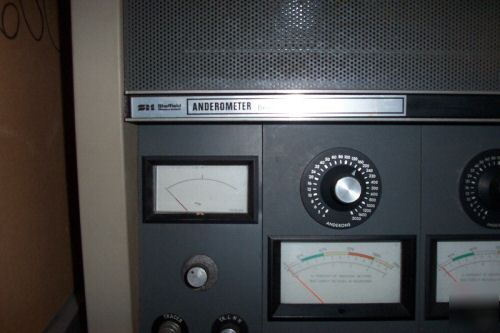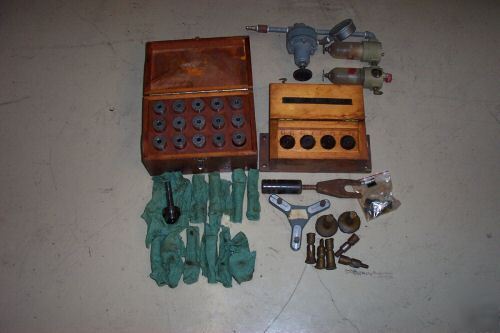Oak Bluffs, MA old classifieds archive and funnies > Ads By members
> Bearing vibration tester anderometer sheffield w/manual
Bearing vibration tester anderometer sheffield w/manual
This is another of dad's cool tools. I know this item used to work, dad used it for years to inspect bearings for turbine engines before installing them. It was disconnected about 5 years ago and has been in storage since. It was working when disconnected.
Description: This instrument is a fast and efficient inspection tool for obtaining an overall quality rating of an anti-friction bearings. It is ruggedly built built for use in production and inspection departments, and is simple and easy to operate. No technical knowledge is required, and anyone can learn to use it in a few minutes. Briefly, the operator simply slips a bearing onto a rotating spindle, restrains the outer bearing race from rotating by a pre-loader, and observes three meters while listening to the bearing sound that comes from a loudspeaker in the instrument cabinet.
The Amplimeter: The BAC Amplimeter is a transistorized amplifier for visual and audio inspection of anti-friction bearings. It is designed to receive a small fluctuating voltage from the Converter, amplify the signal, and deliver it to three Anderon meters and a loudspeaker. The Amplimeter features solid state plug-in modules for ease of servicing; built-in circuitry for calibration inspection; and a tachometer meter for monitoring the spindle speed.
Three Measurement Bands: When ball bearings are in service, a bearing whose balls and races have waviness of predominately long wavelength behaves much differently than a bearing whose waviness is mostly of short wavelengths. Yet, two such bearings could easily give an identical Anderon reading, if the reading included irregularities of all wavelengths. Thus a single over-all Anderon rating would be meaningless for practical purposes. To be of value, the reading must be broken down into two or more wave-bands. Experience has shown that a division of the readout into three wave-bands meets all practical requirements. This permits separation of bearings that growl from those that hum and from those that whistle, and the operator can easily read three meters. In addition, different manufacturing operations produce irregularities with characteristic spacings and defects or changes in manufacturing processes will show up in the meter readings when three wave-bands are used.
Low-Band Meter: This meter shows the effects of long wavelength irregularities - those occurring from 1-2/3 to 10 times per rotation of the inner bearing race [50-300 Hz @ 1800 RPM]. Thus, for example, it has been found that a multiple-jawed chuck will sometimes produce pockets in the raceways, and changes in chuck pressure or in the type of chuck will be definitely shown in the reading of the low-band meter.
Medium-Band Meter: This meter shows the effects of irregularities occurring from 10 to 60 times per rotation of the inner race [300 to 1800 Hz @ 1800 RPM]. Thus this meter will indicate such things as medium-spaced waviness, which might be caused by vibration in the grinding machine that produced the balls or races.
High-Band Meter: This meter shows the effects of irregularities occurring from 60 to 330 times per rotation of the inner race [1800 to 10,000 Hz @ 1800 RPM] , such as closely-spaced chatter marks or widely-spaced roughness irregularities. In addition to identifying production trouble, the selective inspection provided by the three meters is of value in specifying and selecting bearings for various applications.
The Loudspeaker: The Loudspeaker [at the top of the Amplimeter] provides an additional check on the operating characteristics of the bearing under test. Any run of similar bearings produces a characteristic tone that soon becomes familiar to the operator, and deviations from normal are clearly shown by a change in the sound from the loudspeaker. In addition, the loudspeaker discloses the presence of dirt in the bearings, flat spots and scratches on the raceways and balls [or rollers], and other random defects that are too short duration or too infrequent occurrence to register on the meters. Each of these defects produces a sound of its own, and the operator soon learns to identify them. The sound produced by the loudspeaker is not an amplification of sound as would be picked up by a microphone. Instead, it is an audible representation of the movements of the converter tip. Thus is is far more useful and meaningful than the sound directly radiated by the bearing, the operator can hear important things that are not otherwise discernible.
This machine can be used to test bearings with
* Minimum 5/16" Inside Diameter
* Maximum 6" Outside Diameter
This machine has a full selection of bearing adapters and an operations manual is included. This machine will need new plastic air-lines installed, as the old ones have become brittle. This machine is missing 1- 120VAC power cord. Main machine motor operates on 220/440 Volt 3 phase power.







